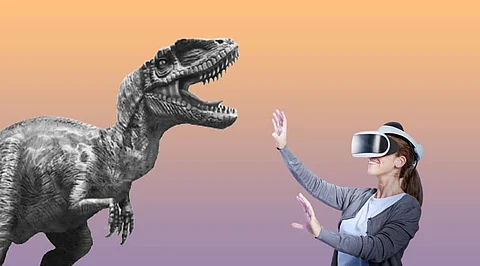
- Insights
- Cryptocurrencies
- Stocks
- White Papers
- Industry
- Geography


Imagine yourself standing on the road and there are tall buildings in front of you. Then suddenly a dragon appears from the back of a building and your mind is blown! Well, augmented reality will let you have this experience as it aims to enhance the real-world environment with the help of digitalized visual images and other virtual sensory stimulations. It provides a whole new level of experience making people's imagination come true. The use of AR has grown a lot through the past decade and museums around the world have started using AR to add a 3D version to their displays and bring objects to life.
Location: Washington D.C.
In 2017, the Smithsonian introduced AR technology to bring a whole new dimension to one of its oldest and most loved displays. Many of the skeletons in the museum's Bone Hall have been on the show since 1881. Now visitors can download a new app called Skin and Bone which shows these pieces in a new light. 13 skeletons feature in the app, which superimposes images to reconstruct the creatures. Users can see how skin and muscle would have looked over the bones, and how the animals would have moved. This gives them a unique glimpse into the history of the pieces and helps to bring the display to life. Visitors can use the app to see a vampire bat take flight, or an anhinga demonstrating how it would have fished. "This app is all about sharing some of the untold stories behind one of the museum's most iconic collections," said Robert Costello. He is the producer of the app and national outreach program manager at the Museum of Natural History.
Location: Singapore
The National Museum of Singapore is currently running an immersive installation called Story of the Forest. The exhibition focuses on 69 images from the William Farquhar Collection of Natural History Drawings. These have been turned into three-dimensional animations that visitors can interact with. Visitors download an app and can then use the camera on their phone or tablet to explore the paintings. The family-friendly installation uses technology to provide a learning experience. Much like Pokémon Go, visitors can hunt for and 'catch' items. In this case, these items are the plants and animals within the paintings. They can then add them to their virtual collection as they walk around the museum. The app shows more information about them once they have been collected. Users can learn facts such as habitat, diet, and how rare the species are. The William Farquhar Collection of Natural History Drawings is one of the museum's most important collections. Created by the Japanese digital art collective teamLab, this AR project brings the drawings to life. Audiences can interact with and explore the images in an exciting new way.
Location: Toronto
In July 2017, the AGO worked with digital artist Alex Mayhew to create an AR installation called ReBlink. Mayhew reimagined some of the existing pieces in the collection. This allowed visitors to view them in a new light. Visitors used their phones or tablets to see the subjects come alive and be transported to our 21st-century reality. For example, the painting Drawing Lots by George Agnew Reid depicts three characters. Their heads bend over their game together in a peaceful spot. In Mayhew's modern version, the three are separate and absorbed in phone screens of their own. Smoky traffic passes by behind. Mayhew is interested in the encroachment of technology on modern life. In his view, we are constantly bombarded by images and as a result, we consume art at a more rapid pace. By using AR for this project, the artist hoped to turn technology into a way to engage rather than distract. The exhibition aimed to use the app to get people to look up, rather than look down. According to the AGO's Interpretive Planner Shiralee Hudson Hill, 84% of visitors to this exhibition reported feeling engaged with the art. 39% looked again at the images after using the app.
Location: Meritt Island, Florida
AR can help visitors to understand historical events by making them appear in 3D. A great example of this is the Heroes and Legends exhibit in the Kennedy Space Centre. Here, an AR experience shows a key moment in the history of America's space program. In June 1966, astronaut Gene Cernan performed the second spacewalk in history. He later called it the 'spacewalk from hell'. His spacesuit overheated and he went into an uncontrollable spin, unable to see. The display shows the Gemini 9 space capsule and uses AR to project a hologram of Cernan over it. Visitors can view the ordeal as he struggles to get back inside the capsule. There is also a voiceover from Cernan himself, describing his experience. The exhibition uses AR holograms throughout. This technology gives faces and voices to the people who worked on the space program. Visitors can hear stories from NASA legends told in their own words.
Location: Miami
In December 2017, PAMM worked with artist Felice Grodin. Together they created the first fully augmented reality-powered art exhibition, called 'Invasive Species'. In the examples above, AR adds to existing works. However, Grodin's work for this project is completely digital. It is intended to be a full AR experience, conjuring images into space. The installation involved a series of digital images and species. These include eerie 3D models evoking creepy crawlies, jellyfish, or cryptic signs. Felice wanted to interact with the architecture of the building and transform it. The exhibition is a comment on the fragility of our ecosystem and the threat of climate change. It transports visitors to a future version of the building, taken over by invasive species. For example, 'Terrafish' invades PAMM's hanging gardens with a 49ft tall jellyfish-like structure. It is reminiscent of a non-native species currently populating the waters around Miami.
